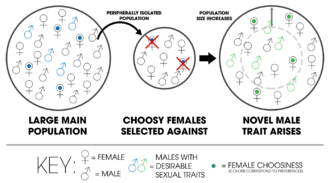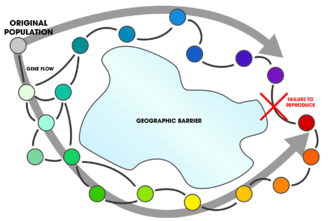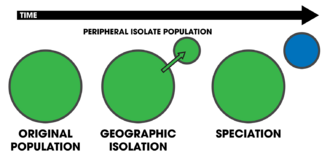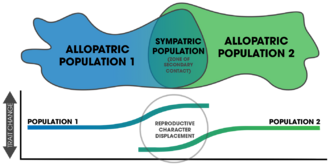Biology:Glossary of speciation
From HandWiki
This glossary of speciation is a list of definitions of terms and concepts used in the study of speciation and related disciplines in evolutionary biology. It is intended as introductory material and a structured organization of the often complex language used in the literature. For additional terms from related glossaries, see Glossary of biology, Glossary of genetics, and Glossary of ecology.
- agamospecies
- A species that does not reproduce sexually but instead by cloning.[1] Agamospecies are sometimes represented by species complexes that contain some diploid individuals and other apomitic forms—in particular, plant species that can reproduce via agamospermy.[2]
- allochronic isolation
- Isolation of two populations of a species due to a change in breeding periods. This isolation acts as a precursor to allochronic speciation, speciation resulting from two populations of a species that have become isolated due to differences in breeding periods. An example is the periodical 13- and 17-year Magicicada species.[2]
- allo-parapatric speciation
- A mode of speciation where divergence occurs in allopatry and is completed upon secondary contact of the populations--effectively a form of reinforcement.[3][2]
- allopatric speciation
- A mode of speciation where the evolution of reproductive isolation is caused by geographic separation of a species population.[4] Also called geographic speciation, vicariance, vicariant speciation, or dichopatric speciation.
- allopatric taxa
- Specific species that are allopatrically distributed.
- allopatry
- Species populations that exist geographically separated from one another.
- allopolyploid
- allo-sympatric speciation
- A mode of speciation where divergence occurs in allopatry and is completed upon secondary contact of the populations--effectively a form of reinforcement.[5][2]
- anagenesis {{defn|Evolutionary change that occurs within a species lineage as opposed to lineage splitting (cladogenesis).[6]
- area cladogram
- assortative mating
- A mating system in which individuals with similar phenotypes mate with each other more frequently than would be expected in a completely random mating system. Assortative mating usually has the effect of increasing genetic relatedness between members of the mating population. Contrast disassortative mating.
- autoallopolyploid
- autopolyploid
- bacterial speciation
- barrier
- behavioral isolation
- biogeography
- The scientific study of the spatial distributions of species. It includes the study of both extinct and extant organisms.[7]
- biological species concept
- bottleneck
- centrifugal speciation
- A variation of peripatric speciation where speciation occurs by geographic isolation, but reproductive isolation evolves in the larger population instead of the peripherally isolated population.[8]
- chimera
- chromosomal speciation
- chronospecies
- cladogenesis
- The splitting of a species lineage into multiple lineages.[6]
- cline
- cluster analysis
- clustering
- character displacement
- cohesion species concept
- colonization
- competitive gametic isolation
- congruent clines
- copulatory behavioral isolation
- coupling
- cospeciation
- Cospeciation is a form of speciation where more than species speciation concurrently due to their ecological associations (e.g. host-parasite interactions).[9]
- cyptic species
- cytoplasmic isolation
- directional speciation
- disassortative mating
- A mating system in which individuals with dissimilar phenotypes mate with each other more frequently than would be expected in a completely random mating system. Disassortative mating usually has the effect of decreasing genetic relatedness between members of the mating population. Contrast assortative mating.
- dispersal
- divergence
- phenotypic or genotypic changes that occur in two different populations or evolutionary lineages.[6]
- divergence-with-gene-flow
- diversification
- Dobzhansky-Muller model
- Drosophila
- A genus of flies commonly known as fruit flies which is used extensively as a model organism in genetics research and laboratory experiments in speciation.
- ecogeographic isolation
- ecological allopatry
- ecological character displacement
- ecological isolation
- ecological niche
- ecological speciation
- A process of speciation where reproductive isolation is caused by the interaction of individuals of a species with their environment.[10]
- ecological species concept
- ecotone
- endemism
- An ecological state of a species being unique to a defined geographic location, such as an island, nation, country or other defined zone, or habitat type.
- environmental gradient
- epistasis
- ethological isolation
- ethological pollinator isolation
- evolution
- evolutionary lineage
- The line of descent of a species.[6]
- evolutionary species concept
- extinction
- extrinsic hybrid inviability
- extrinsic postzygotic isolation
- fitness
- floral isolation
- flowering asynchrony
- fossil
- founder effect
- founder event
- founder-flush-crash
- founder takes all
- A hypothesis that describes the evolutionary advantages of the first-arriving lineages in a new ecosystem.[11] An example could be when a species becomes reproductively isolated on an island as in peripatric speciation.
- gametic isolation
- genealogical species concept
- gene flow
- The transfer of genetic variation from one population to another.
- genetic distance
- genetic drift
- genic speciation
- genotypic cluster species
- geographic speciation
- gradualism
- Continuous evolutionary change within a species lineage.[6]
- habitat isolation
- heteropatric speciation
- history of speciation
- The historical development concerning the thought and ideas about the biological phenomenon of speciation.
- Haldane's rule
- A rule formulated by J.B.S. Haldane that states if one sex of a hybrid between two incipient species is inviable or sterile, that sex is more likely to be the heterogametic sex (i.e. the one with two different sex chromosomes).[12]
- homoploid recombinational speciation
- host race
- host-specific parasite
- host-specific species
- hybrid
- hybrid breakdown
- hybrid incompatibility
- hybrid inviability
- hybridization
- hybrid speciation
- hybrid sterility
- hybrid swarm
- hybrid zone
- incomplete speciation
- incipient species
- Two populations of a species in the early stage of speciation
- interbreeding
- intrinsic postzygotic isolation
- introgression
- inviability
- isolating mechanism
- isolation
- isolation by distance
- Jordan's Law
- Kaneshiro model
- A model of peripatric speciation developed by Kenneth Y. Kanneshiro where a sexual species experiences a population bottleneck—that is, when the genetic variation is reduced due to small population size—mating discrimination among females may be altered by the decrease in courtship behaviors or displays of males. This allows sexual selection to give rise to novel sexual traits in the new population.[13]
- lineage-splitting
- When genetic exchange (gene flow between two populations is eliminated. Also called 'lineage-branching.[6]
- mating system isolation
- mechanical isolation
- mechanical pollinator isolation
- microallopatric
- Allopatric speciation occurring on a small geographic scale.[14]
- microspecies
- migration
- modern synthesis
- modes of speciation
- A classification scheme of speciation processes based on the level of gene flow between two populations.[15] The traditional terms for the three modes—allopatric, parapatric, and sympatric—are based on the spatial distributions of a species population.[16][15]
- morphological species concept
- mosaic
- mosaic hybrid zone
- A zone in which two speciating lineages occur together in a patchy distribution–either by chance, random colonization, or low hybrid fitness.[15]
- mosaic sympatry
- A case of sympatry where two populations overlapping in geographic distribution exhibit habitat specializations.[15]
- natural selection
- niche adaptation
- niche preference
- noncompetitive gametic isolation
- nongenetic barrier
- non-geographic speciation
- paleopolyploidy
- para-allopatric speciation
- A mode of speciation where divergence begins in parapatry, but is completed in allopatry.[2]
- parallel speciation
- parapatric speciation
- paraphyly
- parthenogenesis
- peak shift model
- peripatric speciation
- A variation of allopatric speciation where a new species forms from a small, peripheral isolated population.[17] It is sometimes referred to as centripetal speciation in contrast to centrifugal speciation.
- phylogenetics
- the study of the evolutionary history and relationships among individuals or groups of organisms (e.g. species, or populations).
- phylogenetic species concept
- phylogeography
- phylogeny
- pollinator isolation
- polymorphism
- polyploidy
- population bottleneck
- A sharp reduction in the size of a species population.
- postmating barrier
- postmating prezygotic isolation
- postzygotic isolation
- premating barrier
- premating isolation
- prezygotic isolation
- punctuated equilibrium
- quantum speciation
- A chromosomal model of speciation that occurs rapidly when a cross-fertilizing plant species buds off from a larger population on the periphery, experiencing interbreeding and strong genetic drift that results a new species.[18][19][20] The model is similar to that of Ernst Mayr's peripatric speciation.[21]
- recognition species concept
- recombinational speciation
- refugia
- reinforcement
- A process of speciation where natural selection increases the reproductive isolation between two populations of species as a result of selection acting against the production of hybrid individuals of low fitness.[2] See also Evidence of speciation by reinforcement
- reproductive character displacement
- reproductive isolating barriers
- The set of mechanisms responsible for speciation
- reproductive isolation
- When two species mate and cannot produce fertile offspring. Isolating mechanisms are typically classified as prezygotic (isolating barriers occurring before the formation of a zygote) and postzygotic (isolating barriers occurring after the formation of a zygote).
- ring species
- Connected populations of a species, each of which can interbreed with closely sited related populations, but for which there exist at least two "end" populations in the series, which are too distantly related to interbreed.
- secondary contact
- semi-geographic speciation
- semipermeable species boundary
- The idea that gene flow can occur between two species but that certain alleles at particular loci can exchange whereas others cannot.[15] It is often used to describe hybrid zones and has also been referred to as porous.[15]
- sexual selection
- speciation
- The evolutionary process by which populations evolve to become distinct species.
- speciation experiment
- An experiment that attempts to replicate reproductive isolation in nature in a scientifically controlled, laboratory setting.
- speciation in the fossil record
- Speciation that can be detected as occurring in fossilized organisms.
- speciation rate
- species
- The basic unit of biological classification, a taxonomic rank, and a unit of biodiversity that has no universally agreed upon, satisfactory definition.
- species complex
- species concept
- species problem
- The difficulty in defining what a species is and determining identification of organisms across all of life.[23]
- stasipatric speciation
- stasis
- A species linage that experiences little phenotypic or genotypic change over time.[6]
- stepping-stone speciation
- sterility
- suture zone
- swamping effect
- sympatric speciation
- sympatry
- temporal isolation
- tension zone
- type
- type species
- vicariance biogeography
- A biogeographic approach to species distributions that uses their phylogenetic histories—patterns resulting from allopatric speciation events in the past.[24]
- vicariant speciation
- A biogeographic term meaning the geographic isolation of two species populations (as in allopatric speciation).
- Wahlund effect
- Wallace effect
A

In allopatric speciation, a population becomes separated by a geographic barrier. Reproductive isolation evolves, resulting in two separate species.
B
C
D
E
F
G

Gene flow is the transfer of alleles from one population to another population through immigration of individuals.
H
I
J
K

In the Kaneshiro model of peripatric speciation, a sample of a larger population results in an isolated population with less males containing attractive traits. Over time, choosy females are selected against as the population increases. Sexual selection drives new traits to arise (green), reproductively isolating the new population from the old one (blue).
L
M
N
O
P

A diagram representing population subject to a selective gradient of phenotypic or genotypic frequencies (a cline). Each end of the gradient experiences different selective conditions (divergent selection). Reproductive isolation occurs upon the formation of a hybrid zone. In most cases, the hybrid zone may become eliminated due to a selective disadvantage. This effectively completes the speciation process.
Q
R

Reinforcement assists speciation by selecting against hybrids.

In a ring species, individuals are able to successfully reproduce (exchange genes) with members of their own species in adjacent populations occupying a suitable habitat around a geographic barrier. Individuals at the ends of the cline are unable to reproduce when they come into contact.
S

The four outcomes of secondary contact:
1. An extrinsic barrier separates a species population into two but they come into contact before reproductive isolation is sufficient to result in speciation. The two populations fuse back into one species
2. Speciation by reinforcement
3. Two separated populations stay genetically distinct while hybrid swarms form in the zone of contact
4. Genome recombination results in speciation of the two populations, with an additional hybrid species. All three species are separated by intrinsic reproductive barriers[22]
1. An extrinsic barrier separates a species population into two but they come into contact before reproductive isolation is sufficient to result in speciation. The two populations fuse back into one species
2. Speciation by reinforcement
3. Two separated populations stay genetically distinct while hybrid swarms form in the zone of contact
4. Genome recombination results in speciation of the two populations, with an additional hybrid species. All three species are separated by intrinsic reproductive barriers[22]
T
U
V
W
X
Y
Z
References
- ↑ Oxford Reference (2008), agamospecies, Oxford University Press
- ↑ 2.0 2.1 2.2 2.3 2.4 2.5 Jerry A. Coyne; H. Allen Orr (2004), Speciation, Sinauer Associates, pp. 1–545, ISBN 978-0-87893-091-3
- ↑ Guy L. Bush (1994), "Sympatric speciation in animals: new wine in old bottles", Trends in Ecology & Evolution 9 (8): 285–288, doi:10.1016/0169-5347(94)90031-0, PMID 21236856
- ↑ Howard, Daniel J. (2003). Speciation: Allopatric. doi:10.1038/npg.els.0001748. ISBN 978-0470016176.
- ↑ Guy L. Bush (1994), "Sympatric speciation in animals: new wine in old bottles", Trends in Ecology & Evolution 9 (8): 285–288, doi:10.1016/0169-5347(94)90031-0, PMID 21236856
- ↑ 6.0 6.1 6.2 6.3 6.4 6.5 6.6 Vaux, Felix; Trewick, Steven A.; Morgan-Richards, Mary (2016). "Lineages, splits and divergence challenge whether the terms anagenesis and cladogenesis are necessary". Biological Journal of the Linnean Society 117 (2): 165–76. doi:10.1111/bij.12665.
- ↑ M. V. Lomolino & J. H. Brown (1998), Biography (2 ed.), Sinauer Associates, Sunderland, MA., pp. 3, ISBN 978-0-87893-073-9, https://archive.org/details/biogeography0000brow/page/3
- ↑ Sergey Gavrilets (2000), "Patterns of Parapatric Speciation", Evolution 54 (4): 1126–1134, doi:10.1554/0014-3820(2000)054[1126:pops2.0.co;2]
- ↑ Page, Roderick DM. (2006). Cospeciation. doi:10.1038/npg.els.0004124. ISBN 978-0470016176.
- ↑ Howard D. Rundle and Patrik Nosil (2005), "Ecological Speciation", Ecology Letters 8 (3): 336–352, doi:10.1111/j.1461-0248.2004.00715.x
- ↑ "Founder takes all: density-dependent processes structure biodiversity". Trends in Ecology & Evolution 28. 2013. doi:10.1016/j.tree.2012.08.024.
- ↑ Turelli, M; Orr, H.A. (May 1995). "The Dominance Theory of Haldane's Rule". Genetics 140 (1): 389–402. PMID 7635302.
- ↑ Anders Ödeen & Ann-Britt Florin (2002), "Sexual selection and peripatric speciation: the Kaneshiro model revisited", Journal of Evolutionary Biology 15 (2): 301–306, doi:10.1046/j.1420-9101.2002.00378.x
- ↑ B. M. Fitzpatrick; A. A. Fordyce; S. Gavrilets (2008), "What, if anything, is sympatric speciation?", Journal of Evolutionary Biology 21 (6): 1452–1459, doi:10.1111/j.1420-9101.2008.01611.x, PMID 18823452
- ↑ 15.0 15.1 15.2 15.3 15.4 15.5 Richard G. Harrison (2012), "The Language of Speciation", Evolution 66 (12): 3643–3657, doi:10.1111/j.1558-5646.2012.01785.x, PMID 23206125
- ↑ B. B. Fitzpatrick, J. A. Fordyce, & S. Gavrilets (2009), "Pattern, process and geographic modes of speciation", Journal of Evolutionary Biology 22 (11): 2342–2347, doi:10.1111/j.1420-9101.2009.01833.x, PMID 19732257
- ↑ Michael Turelli, Nicholas H. Barton, and Jerry A. Coyne (2001), "Theory and speciation", Trends in Ecology & Evolution 16 (7): 330–343, doi:10.1016/s0169-5347(01)02177-2
- ↑ Verne Grant (1971), Plant Speciation, New York: Columbia University Press, pp. 432, ISBN 978-0231083263
- ↑ Douglas J. Futuyma (1989), "Speciational trends and the role of species in macroevolution", The American Naturalist 134 (2): 318–321, doi:10.1086/284983
- ↑ Loren H. Rieseberg (2001), "Chromosomal rearrangements and speciation", Trends in Ecology & Evolution 16 (7): 351–358, doi:10.1016/s0169-5347(01)02187-5
- ↑ L. D. Gottlieb (2003), "Rethinking classic examples of recent speciation in plants", New Phytologist 161: 71–82, doi:10.1046/j.1469-8137.2003.00922.x
- ↑ Hvala, John A.; Wood, Troy E. (2012). Speciation: Introduction. doi:10.1002/9780470015902.a0001709.pub3. ISBN 978-0470016176.
- ↑ William P. Hanage (2013), "Fuzzy species revisited", BMC Biology 11 (41): 41, doi:10.1186/1741-7007-11-41, PMID 23587266
- ↑ M. V. Lomolino & J. H. Brown (1998), Biography (2 ed.), Sinauer Associates, Sunderland, MA., pp. 352–357, ISBN 978-0-87893-073-9, https://archive.org/details/biogeography0000brow/page/352





